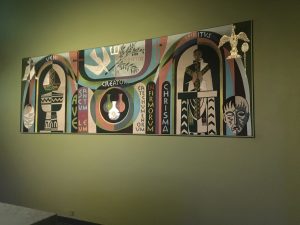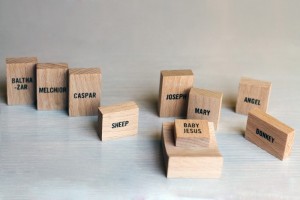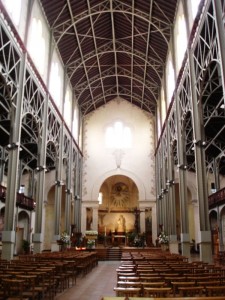Chapel of the English Martyrs, Metropolitan RC Cathedral, Liverpool.


Archive for the ‘Religion’ Category
Page 2 of 9
Wave
In the spirit of the dynamic geometric abstract film projection art of Ludwig Hirschfeld-Mack here is an excerpt from the 2009 video a wave of Peter Campus. The art has been made by slowing down the film, and enlarging selected pixels in a film of surf, abstracting away from the original images, with the sound being that of the breaking surf. The result, like much minimalist art, is meditative and sublime.
The video is part of a current exhibition of Campus’ video art, Video ergo sum, at Jeu de Paume in Paris, France. The image is a still from the video.
Our life is but lent
“Our life is but lent; a good whereof to make, during the loan, our best commodity. It is a debt due to a more certain owner than ourselves, and therefore so long as we have it, we receive a benefit; when we are deprived of it, we suffer no wrong. We are tenants at will of this clayey farm, not for any term of years; when we are warned out, we must be ready to remove, having no other title but the owner’s pleasure. It is but an inn, not a home; we came but to bait, not to dwell; and the condition of our entrance was finally to depart. If this departure be grievous, it is also common; this today to me, tomorrow to thee; and the case equally affecting all, leaves none any cause to complain of injurious usage.”
Robert Southwell SJ: The Triumphs over Death.
Central London churches
A list of some London churches and their denominations, updated as I visit them:
- All Hallows by the Tower, Tower Hill / Anglican
- All Saints Cathedral, Camden / Greek Orthodox, originally Anglican
- Bloomsbury Central Baptist Church, Bloomsbury / Baptist
- Chapel of King’s College London / Anglican
- Chapel of Hospital of St John and St. Elizabeth, St John’s Wood / Roman Catholic
- Chapel of St. Thomas’ Hospital, Lambeth / Anglican
- Christ Church, Spitalfields / Anglican
- Christ-the-King, Gordon Square / Catholic Apostolic
- Corpus Christi, Maiden Lane, Covent Garden / Roman Catholic
- St Cyprian’s Church, Clarence Gate / High Church Anglican
- Emmanuel Temple, Westminster / Evangelical Christian
- Finchley Quaker Meeting House / Society of Friends
- Friends House, Euston / Society of Friends
- St George’s, Hanover Square / Anglican
- Holy Trinity, Marylebone / Anglican
- Holy Trinity, Sloane Square / Anglican
- The Little Oratory Chapel, Kensington / Roman Catholic
- Queen’s Chapel of the Savoy / Anglican
- St Andrew Undershaft, St Mary Axe / Anglican
- St Anselm and St Cecilia, Holborn / Roman Catholic
- St Bride’s, Fleet Street (the Journalists’ Church) / Anglican
- St Clement Danes / Anglican (the home church of the RAF)
- St Clement’s Eastcheap / Anglican
- St Dunstan-in-the-West, Fleet Street / Anglican and Romanian Orthodox
- St Etheldreda’s, Ely Place, Holborn / Roman Catholic
- St Giles Cripplegate, Barbican / Anglican
- St Giles-in-the-Fields / Anglican
- Church of the Immaculate Conception, Farm Street, Mayfair / Jesuit, Roman Catholic
- St James, Piccadilly / Anglican
- St James, Sussex Gardens / Anglican
- St John’s, Smith Square / formerly Anglican
- St John’s, Waterloo /Anglican
- St John’s Wood Church / Anglican
- St Katherine Cree, Leadenhall / Anglican
- St Luke’s, Old Street / formerly Anglican
- St Magnus the Martyr, Monument / Anglican
- St Margaret, Lothbury / Anglican
- St Margaret’s Putney / Anglican
- St Martin, Ludgate (the Guild Church of St Martin-within-Ludgate) / Anglican
- St Mary Abbots, Kensington / Anglican
- St Mary Aldermary / Anglican
- St Mary, Finchley East / Roman Catholic
- St Marylebone, Marylebone / Anglican
- St Mary-le-Bow / Anglican
- St Mary-le-Strand / Anglican
- St Mary Moorfields / Roman Catholic
- St Mary Woolnoth / Anglican
- Church of the Most Precious Blood, Borough / Roman Catholic – Ordinariate of Our Lady of Walsingham
- St Pancras New Church, Euston / Anglican
- St Pancras Old Church, Somers Town / Anglican
- St Paul’s, Hammersmith / Anglican
- St Paul’s Cathedral / Anglican
- St Paul’s Church, Covent Garden (the Actors’ Church) / Anglican
- St Peter’s Church on Eaton Square / Anglican
- St Peter’s Italian Church, Holborn / Roman Catholic
- St Sepulchre-without-Newgate / Anglican
- St Stephen’s Church, Rosslyn Hill, Hampstead / formerly Anglican
- St Stephen Walbrook / Anglican
- Swiss Church, Endell Street / Protestant
- Temple Church / Anglican
- Wesley’s Chapel, Finsbury / Methodist
- Westminster Cathedral / Roman Catholic
- Westminster Quaker Meeting House / Society of Friends
The need for enchantment
I just described our contemporary western culture as pseudo-rationalist materialism arising from a Protestant disdain for the supernatural, pagan aspects of Catholicism. I recalled a 2015 column by New York Times op-editor David Brooks on the need for enchantment in our lives. A willingness to accept enchantment is indeed a counter-cultural act.
The dating sites have taken the information available online and tried to use it to match up specific individuals. They’ve failed. An exhaustive review of the literature by Eli J. Finkel of Northwestern and others concluded, “No compelling evidence supports matching sites’ claims that mathematical algorithms work.” That’s because what creates a relationship can’t be expressed in data or photographs. Being in love can’t be done by a person in a self-oriented mind-set, asking: Does this choice serve me? Online dating is fascinating because it is more or less the opposite of its object: love.
When online daters actually meet, an entirely different mind-set has to kick in. If they’re going to be open to a real relationship, they have to stop asking where this person rates in comparison to others and start asking, can we lower the boundaries between self and self. They have to stop thinking in individual terms and start feeling in rapport terms.
Basically, they have to take the enchantment leap. This is when something dry and utilitarian erupts into something passionate, inescapable and devotional. Sometimes a student becomes enraptured by the beauty of math, and becomes a mathematician. Soldiers doing the drudgery of boot camp are gradually bonded into a passionate unit, for which they will risk their lives. Anybody who has started a mere job and found in it a vocation has taken the enchantment leap.
In love, of course, the shift starts with vulnerability, not calculation. The people involved move from selfishness to service, from prudent thinking to poetic thinking, from a state of selection to a state of need, from relying on conscious thinking to relying on their own brilliant emotions.
When you look at all the people looking for love and vocation today, you realize we live in a culture and an online world that encourages a very different mind-set; in a technical culture in which humanism, religion and the humanities, which are the great instructors of enchantment, are not automatically central to life.
I have to guess some cultures are more fertile for enchantment — that some activities, like novel-reading or music-making, cultivate a skill for it, and that building a capacity for enchantment is, these days, a countercultural act and a practical and fervent need.”
Reference:
David Brooks [2015]: The devotion leap. New York Times International Edition, 24-25 January 2015, page 9.
The image is “The Spirit of the Plains” (1897) by Sydney Long (1871-1955), now in the Queensland Art Gallery, Brisbane.
Of things unseen
I have remarked before that anyone who has spent any extended period living in Africa or Asia will have encountered people with strong beliefs, beliefs based on their own direct, personal experiences, in the existence of a non-material realm. In many places, the overwhelming majority of people have such beliefs. It may be that the majority of westerners, too, have had such experiences but our contemporary culture (pseudo-rationalist materialism arising from a Protestant disdain for the supernatural and pagan aspects of Catholicism) inhibits their public expression, or even, sometimes, their private recognition.
Strangely, my thoughts on this subject I find mirrored uncannily by Lafcadio Hearn (1850-1904), writing 120 years ago. Here is Hearn, writing about Shintô temples in Japan and his reactions to the associated beliefs:
Why certain architectural forms produce in the beholder a feeling of weirdness is a question about which I should like to theorize some day; at present I shall venture only to say that Shintô shrines evoke such a feeling. It grows with familiarity instead of weakening; and a knowledge of popular beliefs is apt to intensify it. We have no English words by which these queer shapes can be sufficiently described, – much less any language able to communicate the peculiar impression which they make. Those Shintô terms which we loosely render by the words “temple” and “shrine” are really [page-break] untranslatable; — I mean that the Japanese ideas attaching to them cannot be conveyed by translation. The so-called “august house” of the Kami is not so much a temple, in the classic meaning of the term, as it is a haunted room, a spirit-chamber, a ghost-house; many of the lesser divinities being veritably ghosts, — ghosts of great warriors and heroes and rulers and teachers, who lived and loved and died hundreds or thousands of years ago. I fancy that to the Western mind the word “ghost-house” will convey, better than such terms as “shrine” and “temple,” some vague notion of the strange character of the Shintô miya or yashiro, — containing in its perpetual dusk nothing more substantial than symbols or tokens, the latter probably of paper. Now the emptiness behind the visored front is more suggestive than anything material could possibly be; and when you remember that millions of people during thousands of years have worshiped their great dead before such yashiro, — that a whole race still believes those buildings tenanted by viewless conscious personalities, — you are apt also to reflect how difficult it would be to prove the [page-break] faith absurd. Nay! In spite of Occidental reluctances, — in spite of whatever you may think it expedient to say or not to say at a later time about the experience, — you may very likely find yourself for a moment forced into the attitude of respect towards possibilities. Mere cold reasoning will not help you far in the opposite direction. The evidence of the senses counts for little: you know there are ever so many realities which can neither be seen nor heard nor felt, but which exist as forces, — tremendous forces. Then again you cannot mock the conviction of forty millions of people while that conviction thrills all about you like air, — while conscious that it is pressing upon your psychical being just as the atmosphere presses upon your physical being. As for myself, whenever I am alone in the presence of a Shintô shrine, I have the sensation of being haunted; and I cannot help thinking about the possible apperceptions of the haunter. And this tempts me to fancy how I should feel if I myself were a god, — dwelling in some old Izumo shrine on the summit of a hill, guarded by stone lions and shadowed by a holy grove. (Hearn 1897, pages 2-4)”
Reference:
Lafcadio Hearn [1897]: Gleanings in Buddha-Fields: Studies of Hand and Soul in the Far East. London, UK: Kegan Paul, Trench, Trubner & Company Limited.
Brussels life
Paris at Easter
London Life
In solidarity with the people of France, and in support of human civilization, Trafalgar Square an hour ago.
A Minimalist Nativity Scene
A minimalist Nativity scene, by Emilie Voirin:


